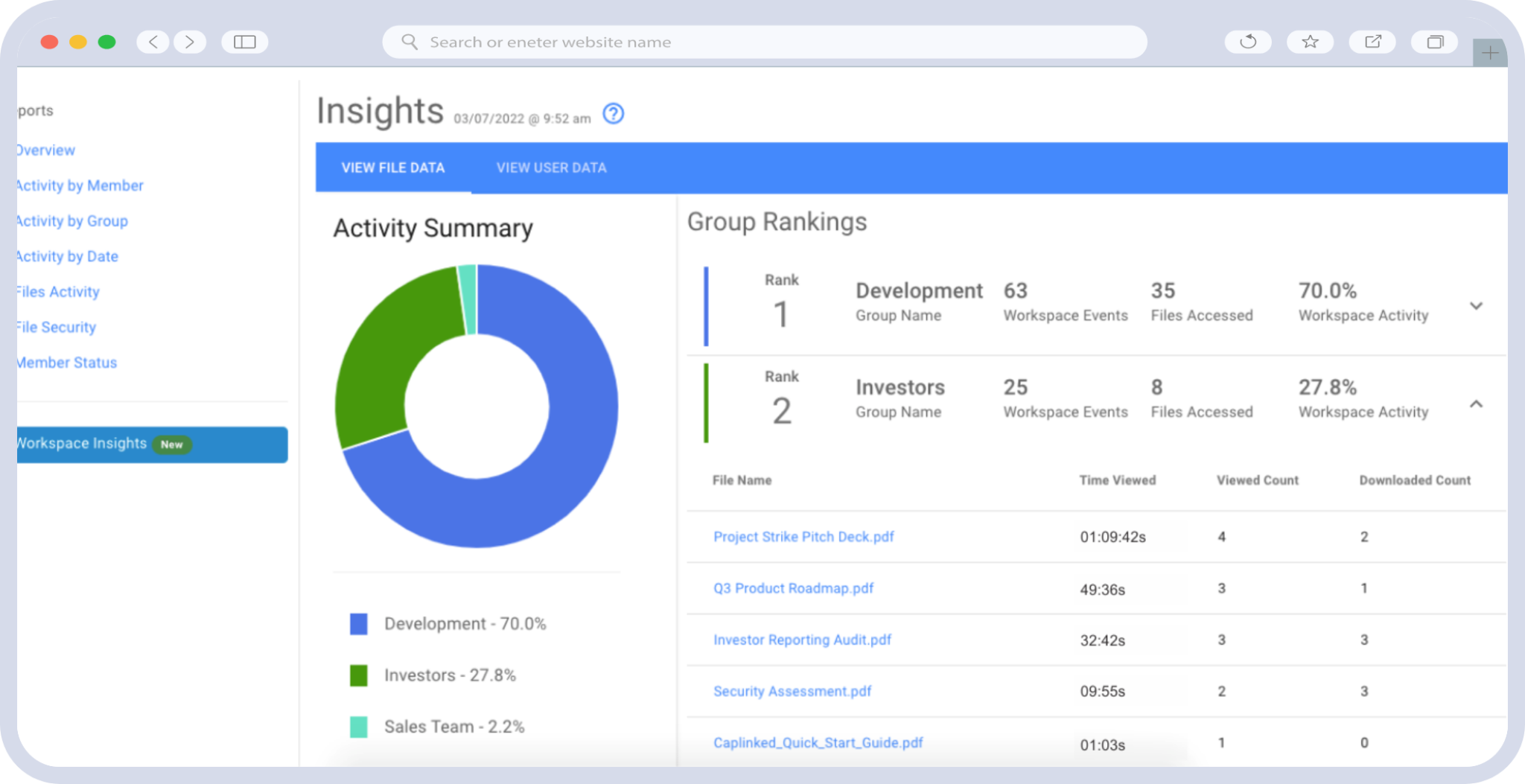Secondary transactions in private equity might sound like insider jargon, but if you’ve ever needed to quickly rearrange your investment portfolio, raise cash, or shift strategies midstream, you’re already familiar with the concept.
Think about this scenario: You’ve invested in a private equity fund, and things are running smoothly—until they’re not. Maybe you need liquidity fast. Or perhaps the market shifts, and your strategy no longer aligns with your original investment. That’s when secondary transactions become your best friend, giving you an exit ramp without forcing you to wait for the typical private equity lifecycle.
But here’s the catch—secondary transactions are notoriously complicated. They’re not just about moving money around; they’re about navigating intricate paperwork, conducting detailed due diligence, and managing highly confidential information.
That’s exactly where a secure data room, like CapLinked’s Virtual Data Room, steps in. But before we talk solutions, let’s first break down exactly what secondary transactions are—and why investors increasingly rely on them.
Table of Contents
ToggleUnderstanding Secondary Transactions
In simple terms, secondary transactions happen when investors sell their existing stakes in private equity funds or private companies to another investor. Unlike primary transactions, where you’re pouring new money into a fresh opportunity, secondaries are all about buying or selling what’s already there.
Why do investors do this? For starters, flexibility. You don’t always want to (or can’t) wait around ten years until a private equity fund exits. Secondary transactions give investors a much-needed shortcut, offering immediate liquidity to rebalance their portfolios or respond swiftly to new opportunities.
Think of secondary transactions as a high-stakes version of trading baseball cards—but instead of rookie cards, you’re dealing with multimillion-dollar stakes in companies or funds. It’s fast-paced, highly strategic, and, if handled correctly, immensely beneficial to both buyers and sellers.
Types of Secondary Transactions
Secondary transactions generally fall into two main buckets:
Fund Secondaries
These are the most common. Let’s say you’ve invested as a Limited Partner (LP) in a private equity fund, but circumstances change—maybe you’re shifting your investment strategy, or a new opportunity demands immediate cash. You’d then sell your LP stake to another investor willing to step into your shoes.
There’s also the increasingly popular General Partner (GP)-led secondary, a common feature in complex M&A environments. This happens when the fund manager initiates the transaction, usually because they see value in extending a fund’s timeline or providing liquidity to investors without prematurely selling the assets.
Direct Secondaries
These are simpler, at least conceptually. Instead of transferring fund interests, you’re directly selling or buying stakes in specific private companies. Direct secondaries often happen when investors want to cherry-pick particular assets or exit specific companies rather than entire funds.
No matter which type you’re dealing with, secondary transactions share one big common denominator: complexity. To navigate these complexities—and to ensure your sensitive data stays exactly where it should—you need a secure, streamlined solution.
And that’s exactly what we’ll unpack next: why a secure data room isn’t just helpful—it’s essential.
Key Reasons Investors Turn to Secondary Transactions
Now that we’ve defined secondary transactions, let’s tackle a key question: why exactly do investors pursue them? The reasons vary widely, but they typically boil down to a few common scenarios:
- Liquidity Needs: Sometimes, life (or the market) demands quick access to cash. Secondary transactions help investors tap into locked-up investments without waiting years for exits.
- Portfolio Rebalancing: Maybe your fund is overweight in technology and underweight in healthcare, or you simply need to rebalance risk. Secondaries offer a quick pivot point, allowing you to recalibrate swiftly and effectively.
- Strategic Shifts: Markets change. Your firm’s investment strategy evolves. Maybe you’re chasing different returns or need to react to shifting regulatory requirements. Secondary transactions give you room to adapt, fast.
- Risk Management: Selling stakes in private equity funds or companies can help investors shed risk or reposition their portfolios to match evolving comfort levels.
But here’s the twist: these transactions aren’t just about convenience. They also present real, tangible benefits like freeing capital for new opportunities or reducing exposure in volatile markets. In short, they give investors control when they need it most.
Common Challenges Faced in Secondary Transactions
Sure, secondary transactions sound great—who doesn’t love flexibility? But there’s a catch: they’re notoriously tricky to pull off smoothly. Navigating them often means facing down a handful of serious challenges:
- Complex Valuations
Assigning a price to existing private equity stakes isn’t like checking a stock ticker. It involves sophisticated valuation models, projections, and often lengthy negotiations. - Rigorous Due Diligence
Due diligence isn’t just a formality—it’s a deal breaker. Investors must carefully review detailed documents, historical financial performance, legal agreements, and more. Miss something small, and you risk large losses. - Confidentiality Concerns
Secondary transactions involve sensitive data—financial records, strategic plans, partnership agreements—information that, in the wrong hands, could cause serious harm. - Deal Fatigue
M&A Deals can drag on, bogged down by paperwork, version control chaos, or slow communications. The longer it takes, the higher the risk of losing momentum—or worse, losing the deal entirely.
Clearly, navigating these transactions isn’t a walk in the park. But what if there was a better way? (Spoiler alert: there is.)
Why Secure Data Rooms are Essential in Secondary Transactions
This brings us to the game-changing role of secure data rooms—because handling secondary transactions without one is a bit like building a house without tools: frustrating, inefficient, and risky.
Here’s why a secure virtual data room (VDR) is a critical tool for private equity secondaries:
- Centralized Document Management
Imagine replacing scattered email attachments, Dropbox folders, and overflowing inboxes with one intuitive, organized hub. A VDR centralizes everything, from financial statements and legal documents to fund performance reports, keeping your deal efficient and structured. - Accelerated Due Diligence
With a secure data room, due diligence goes from chaotic to streamlined. Stakeholders can quickly search, review, and annotate documents without confusion. This drastically speeds up decision-making and keeps your transaction humming along smoothly. - Superior Security
Let’s face it—data leaks or breaches aren’t just embarrassing; they’re financially devastating. A secure data room provides robust protection including:- End-to-end encryption
- Multi-factor authentication (MFA)
- Dynamic watermarking
- Comprehensive audit trails
- End-to-end encryption
- Enhanced Collaboration and Engagement
Secure data rooms don’t just store documents—they also foster collaboration. Built-in Q&A features and real-time notifications ensure stakeholders stay engaged and informed, reducing deal fatigue.
How CapLinked’s Virtual Data Room Supports Secondary Transactions
So where does CapLinked fit into all of this? Glad you asked.
CapLinked’s Virtual Data Room isn’t your typical file-sharing solution. It’s specifically designed to simplify complex transactions in private equity—particularly secondary transactions. Here’s how CapLinked brings clarity, security, and speed to the secondary market:
- Intuitive Document Organization: Documents are neatly structured and searchable, making critical information accessible in seconds.
- Powerful Security Features: CapLinked keeps your data secure and compliant, protecting your investment interests and ensuring confidentiality.
- Advanced Access Controls: Easily set permission levels for individual users or groups, making sure the right eyes see the right files at precisely the right time.
- Transparent Deal Monitoring: Real-time analytics and detailed audit trails let you track engagement, identify potential roadblocks, and resolve issues proactively.
Think of CapLinked like your secret weapon—streamlining complexity, reducing risk, and keeping your secondary transactions on point and on pace.
Best Practices for Implementing a Virtual Data Room in Your Secondary Transaction
Ready to give your secondary transaction a serious advantage? Here’s how to get the most out of your virtual data room:
- Clearly Define User Roles and Permissions: Don’t overlook this step—controlling who sees what is critical for security and efficiency.
- Maintain Organized Document Structures: Create logical, easy-to-follow folders to prevent confusion and speed up due diligence.
- Monitor Activity Regularly: Use built-in analytics to gauge engagement, spot delays early, and resolve questions promptly.
- Use Built-in Communication Features: Encourage stakeholders to ask questions and receive prompt answers directly within the data room, keeping communication clear and focused.
A Secure Data Room For Your Secondary Transactions
Secondary transactions are powerful tools, giving private equity investors the flexibility, liquidity, and control they need. But complexity and confidentiality are always at stake.
CapLinked’s Virtual Data Room tackles these challenges head-on, providing security, efficiency, and transparency to keep your deal moving quickly and smoothly.
Ready to see how CapLinked can make your next secondary transaction simpler, safer, and more successful?
Reach out for a personalized demo today and discover why leading investors choose CapLinked.




